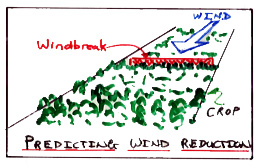 Perturbation Analysis of Windbreak Flow
Perturbation Analysis of Windbreak Flow Perturbation Analysis of Windbreak Flow
Perturbation Analysis of Windbreak FlowOur solution is a substantial improvement over earlier ones, which without exception treated momentum as a diffusing passive scalar, and neglected entirely the pressure field (eg. Kaiser, 1959; "Die Strömung an Windschutzstreifen {The airflow through shelterbelts}," Berichte Deutscher Wetterdienstes, No. 53, Band 7. In German). Due to our proper coupling of the velocity and pressure fields, we obtain (correctly) that the minimum velocity lies downstream from the barrier. Our solution is also compared with numerical solutions for windbreak flow (bounded, inhomogeneous turbulence). It is shown that all these solutions demonstrate a rate of recovery of the mean velocity field which is slower than is observed. It is suggested that the weakness of all the solutions lies in the treatment of the Reynolds stresses.
A further point of interest is that a useful approximation to the pressure field may be obtained by dropping the Reynolds stress terms and solving a simplified equation expressing a balance between streamwise advection, pressure gradient, and localised momentum removal at the barrier; this might prove useful for the solution of more general porous barrier flows.